Platy Galena from the Viburnum Trend, Southeast Missouri: Character, Mine Distribution, Paragenetic Position, Trace Element Content, Nature of Twinning, and Conditions of Formation
Abstract
:1. Introduction
2. General Geology of the Viburnum Trend
3. Previous Investigations of Viburnum Galena Morphology
4. Platy Galena in the Viburnum Trend
5. Present Study of Viburnum Platy Galena
6. Paragenetic Position of Viburnum Platy Galena Deposition
7. Spinel-Twinned Octahedral Galena from Germany, Russia, Bulgaria, and Mexico
7.1. Gonderbach Silver Mine, Germany
7.2. Dalnegorsk Pb-Zn Mine, Russia
7.3. Madan Ore Field, Southern Bulgaria
7.4. Naica Lead Mine, Northwestern Mexico
8. Other Viburnum Mines that Contain Spinel-Twinned Galena
9. Role of Trace Elements in the Morphologic Development of Galena
10. Observations by Viburnum Mine Geologists
11. Role of Rapid Crystallization in the Formation of Spinel-Twinned Viburnum Galena
12. Summary and Conclusions
Acknowledgments
Conflicts of Interest
References
- Mavrogenes, J.A.; Hagni, R.D.; Dingess, P.R. Mineralogy, paragenesis, and mineral zoning of the West Fork mine, Viburnum Trend, southeast Missouri. Econ. Geol. 1992, 87, 113–124. [Google Scholar] [CrossRef]
- Kisvarsanyi, G. The role of the Precambrian igneous basement in the formation of the stratabound lead-zinc-copper deposits in southeast Missouri. Econ. Geol. 1977, 72, 435–442. [Google Scholar] [CrossRef]
- Cavender, B.D.; Shelton, K.L.; Schiffbauer, J.D. An atypical orebody in the Brushy Creek mine, Viburnum Trend, MVT district, Missouri: Early Cu-(Ni-Co)-Zn-rich ores at the Lamotte Sandstone/Bonneterre Dolomite contact. Econ. Geol. 2016, 111, 259–269. [Google Scholar] [CrossRef]
- Gerdemann, P.E.; Myers, H.E. Relationships of carbonate facies patterns in ore distribution and to ore genesis in the Southeast Missouri Lead District. Econ. Geol. 1972, 67, 426–433. [Google Scholar] [CrossRef]
- Appold, M.S.; Garven, G. The hydrology of ore formation in the southeast Missouri district: Numerical models of topography-driven fluid flow during the Ouachita Orogeny. Econ. Geol. 1999, 94, 913–936. [Google Scholar] [CrossRef]
- Gregg, J.M.; Shelton, K.L. Minor and trace element distribution in the Bonneterre Dolomite (Cambrian), Southeast Missouri: Evidence for possible multiple basin fluid sources and pathways during lead-zinc mineralization. Geol. Soc. Am. Bull. 1989, 101, 163–186. [Google Scholar] [CrossRef]
- Leach, D.L.; Rowan, E. Genetic between Ouachita Fold Belt tectonism and the Mississippi Valley-type Pb-Zn deposits of the Ozarks. Geology 1986, 14, 931–934. [Google Scholar] [CrossRef]
- Leach, D.L.; Taylor, R.D.; Fey, D.L.; Diehl, S.F.; Saltus, R.W. A Deposit Model for Mississippi Valley-Type Lead-Zinc Ores, Chapter A of Mineral Deposit Models for Resource Assessment; U.S. Geological Survey Scientific Investigations Report 2010-5070-A; U.S. Geological Survey: Reston, VA, USA, 2010; p. 52.
- Hagni, R.D. Mineral paragenetic sequence of the lead-zinc-copper-cobalt-nickel ores of the Southeast Missouri Lead District, U.S.A. In Mineral Parageneses; Craig, J.R., Hagni, R.D., Kiesl, W., Lange, I.M., Petrovskaya, N.V., Shadlun, T.N., Udubasa, G., Augustithis, S.S., Eds.; Theophrastus Publications S.A.: Athens, Greece, 1986; pp. 90–132. [Google Scholar]
- Hagni, R.D. Ore microscopy, paragenetic sequence, trace element content, and fluid inclusion studies of the copper-lead-zinc deposits of the Southeast Missouri Lead District. In Proceedings of the International Conference on Mississippi Valley Type Lead-Zinc Deposits, Rolla, MO, USA, 2 October 1982. [Google Scholar]
- Appold, M.S. Determination of Zn Concentrations in Ore Fluids from Solid Solutions in Calcite: Application to Carbonate-Hosted Base Metal Ore Deposits; Seminar Abstract; Department of Geosciences and Geological and Petroleum Engineering, Missouri University of Science and Technology: Rolla, MO, USA, 2018. [Google Scholar]
- Brannon, J.C.; Podosek, F.A.; Viets, J.G.; Leach, D.L.; Goldhaber, M.; Rowan, E.L. Strontium isotopic constraints on the origin of ore-forming fluids of the Viburnum Trend, southeast Missouri. Geochem. Cosmochem. Acta 1991, 55, 1407–1419. [Google Scholar] [CrossRef]
- Hagni, R.D. Possible causes for significant variations in chemical and mineralogical compositions among the major ore districts in the Mississippi Valley: Tri-State Zinc District, Southeast Missouri Lead District, and Southern Illinois-Kentucky Fluorite District. Illinois State Geological Survey Circular. In Proceedings of the 47th Forum on the Geology of Industrial Minerals, Champaign, IL, USA, 15–17 May 2011; Lasemi, Z., Ed.; Illinois State Geological Survey: Champaign, IL, USA, 2015; Volume 587, pp. 67–76. [Google Scholar]
- Hagni, R.D. Ore microscopy and paragenetic sequence of early bornite ores in the Southeast Missouri Lead District. In Proceedings of the 7th Quadrennial IAGOD Symposium, Luleå, Sweden, 18–22 August 1986; Zachariasson, E., Ed.; E. Schweizerbart’sche Verlagsbuchhandlung: Stuttgart, Germany, 1988; pp. 167–170. [Google Scholar]
- Hagni, R.D. Mineralogy and textures of bornite ores in the Sweetwater Mine, Viburnum Trend, Southeast Missouri. Abstracts with Programs. In Proceedings of the 44th Annual Meeting North-Central Geological Society of America, Branson, MO, USA, 11–13 April 2010; Missouri University of Science and Technology: Rolla, MO, USA, 2014. [Google Scholar]
- Hagni, R.D.; Sun, J. Ultra fine-grained shale-hosted Pb-Zn ores, Viburnum Trend, USA. In Proceedings of the Fifth Biennial SGA meeting and the Tenth Quadrennial IAGOD Symposium, London, UK, 22–25 August 1999; Stanley, C.J., Ed.; A. A. Balkema: Rotterdam, The Netherlands, 1999; pp. 155–158. [Google Scholar]
- Sun, J.; Hagni, R.D.; Dunn, R.G., Jr. Unusual, rapidly precipitated, fine-grained, dendritic-textured, shale-hosted, copper-lead ores, Viburnum Trend, Southeast Missouri. In Studies on Ore Deposits, Mineral Economics, and Applied Mineralogy: With Emphasis on Mississippi Valley-Type Base Metal and Carbonatite-Related Ore Deposits; Hagni, R.D., Ed.; University of Missouri-Rolla: Rolla, MO, USA, 2001. [Google Scholar]
- Voss, R.L.; Hagni, R.D. The application of cathodoluminescence microscopy to the study of sparry dolomite from the Viburnum Trend, southeast Missouri. In Mineralogy—Applications to the Minerals Industry, Proceedings of the Paul F. Kerr Memorial Symposium, New York, NY, USA, 28 February 1985; Hausen, D.M., Kopp, O.C., Eds.; Society of Mining Engineers: New York, NY, USA, 1985; Chapter 5; pp. 51–68. [Google Scholar]
- Voss, R.L.; Hagni, R.D.; Gregg, J.M. Sequential deposition of zoned dolomite and its relationship to sulfide mineral paragenesis in the Viburnum Trend, southeast Missouri, Special Issue on The Relationships Between Dolomitization, Basin Development, and Mississippi Valley-Type Ore Deposits. Carbonates Evaporites 1989, 4, 195–209. [Google Scholar] [CrossRef]
- Gregg, J.M. Regional epigenetic dolomitization in the Bonneterre Dolomite (Cambrian), Southeastern Missouri. Geology 1985, 13, 503–506. [Google Scholar] [CrossRef]
- Rowan, E.L. Carhodoluminescent zonation of hydrothermal cements: Relationship to Mississippi Valley-Type Pb-Zn mineralization in southern Missouri and northern Arkansas. In Process Mineralogy VI; Hagni, R.D., Ed.; The Metallurgical Society: Warrendale, PA, USA, 1986; pp. 69–87. [Google Scholar]
- Hagni, R.D. The Southeast Missouri Lead District: A review. In Mississippi Valley-Type Mineralization of the Viburnum Trend; Society of Economic Geologists Guidebook 5; Hagni, R.D., Coveney, R.M., Eds.; Citizen Printing Co., Inc.: Fort Collins, CO, USA, 1989; pp. 12–57. [Google Scholar]
- Hagni, R.D. The copper-lead-Zinc ore deposits of the Viburnum Trend, Southeast Lead District Missouri: Their mineralogy, ore textures, ore controls, and origin. In Proceedings of the Symposium on the Geology of the Kapadokya Region, Nigde, Turkey, 17–20 October 2007; pp. 184–189. [Google Scholar]
- Hagni, R.D. The ore deposits of the South-East Missouri cobalt-copper-lead-zinc district: Mineralogy, ore textures, applied mineralogy and ore controls. In Proceedings of the 9th International Congress for Applied Mineralogy, Brisbane, Australia, 8–10 September 2008; Gu, Y., Ed.; Australasian Institute of Mining and Metallurgy: Carlton, Australia, 2008; pp. 29–38. [Google Scholar]
- Hagni, R.D.; Trancynger, T.C. Sequence of deposition of the ore minerals at the Magmont Mine. Econ. Geol. 1977, 72, 451–464. [Google Scholar] [CrossRef]
- Lasmanis, R. Galena from Mississippi Valley-type deposits. Rocks Miner. 1989, 64, 10–34. [Google Scholar] [CrossRef]
- Lasmanis, R. Tri-State and Viburnum Trend Districts: An overview. Rocks Miner. 1997, 72, 400–419. [Google Scholar] [CrossRef]
- Fennel, M.J.; Hagni, R.D. Mineralogy, Paragenetic sequence, and mineral zoning at the Magmont-West Mine, Viburnum Trend, Southeast Missouri Lead District. In Carbonate-Hosted Lead-Zinc Deposits; Sangster, D.F., Ed.; Society of Economic Geologists: Littleton, CO, USA, 1997; pp. 597–610. [Google Scholar]
- Sun, Y.; Hagni, R.D.; Walker, W.T. Characterization of cuboctahedral galena and its areal distribution. In Pb-Zn-Cu Ores at the Sweetwater Mine, Viburnum Trend, Southeast Missouri. Carbonate-Hosted Lead-Zinc Deposits; Sangster, D.F., Ed.; Society of Economic Geologists: Littleton, CO, USA, 1997; pp. 587–596. [Google Scholar]
- Sun, Y.; Hagni, R.D.; Walker, W.T.; Wagner, R.J. Classification and areal distributions of galena morphologies in a Mississippi Valley-type deposit, Sweetwater mine, Viburnum Trend, Southeast Missouri, U.S.A. In Proceedings of the Ninth IAGOD Symposium, International Association on the Genesis of Ore Deposits, Beijing, China, 12–18 August 1994; Hagni, R.D., Ed.; Schweizerbart’sche Verlagsbuchhandlung: Stuttgart, Germany, 1998; pp. 131–142. [Google Scholar]
- Clendenin, C.W. Suggestions for interpreting Viburnum Trend mineralization based on field studies at Ozark Lead Company, Southeast Missouri. Econ. Geol. 1977, 72, 465–473. [Google Scholar] [CrossRef]
- Clendenin, C.W.; Rickman, D.L. Suggestions for interpreting Viburnum Trend mineralization based on field studies at Ozark Lead Company, Southeast Missouri: II. Precipitation models. South-Central Section Geological Society of America Abstracts with Programs. (Abstract). Econ. Geol. 1979, 72, 465–473. [Google Scholar] [CrossRef]
- Kolbe, E. Die bleierziagerstasse Gonderbach bei Laasphe und ihre entstehung. Neues Jahrb. Miner. 1925, 30, 286–333. [Google Scholar]
- Gonderbach Mine, Fischelbach, Bad Laasphe, North Rhine-Westphalia, Germany. Available online: https://www.mindat.org/loc-11415.html (accessed on 24 January 2018).
- Image of Spinel-Twinned Galena from Gonderbach Mine in Germany. Available online: https://www.mindat.org/loc-11415.html (accessed on 24 January 2018).
- Image of Spinel-Twinned Galena from Dalnagorsk Mine in Russia. Available online: http://www.minfind.com/mineral-142412.html (accessed on 27 December 2012).
- Kellogg, W.R. Mineral Specimen #215 Spinel Twins Galena. Available online: http://www.mwminerals.com/m215_Spinel_Galena_Bulgaria.html (accessed on 27 December 2012).
- The Arkenstone. Available online: www.iRocks.com (accessed on 28 December 2012).
- Garofalo, P.S.; Fricker, B.M.; Gunther, D.; Forti, P.; Mercuri, A.; Loreti, M.; Capaccioni, B. Climatic control on the growth of gigantic gypsum crystals within hypogenic caves (Naica mine, Mexico). Earth Planet. Sci. Lett. 2010, 289, 560–569. [Google Scholar] [CrossRef]
- Schroll, Erich; Universitat Wien, Vienna, Austria. Personal communication, 1995.
- Bonev, I.K. Crystal habit of Ag-, Sb- and Bi-bearing galena from the Pb-Zn ore deposits in the Rhodope Mountains. Geochem. Mineral. Petrol. 2007, 45, 1–18. [Google Scholar]
- Atanassova, R.; Bonev, I.K. Two crystallographically different types of skeletal galena associated with colloform sphalerite. Geochem. Mineral. Petrol. 2006, 44, 1–88. [Google Scholar]
- Hagni, R.D. Minor elements in Mississippi Valley-Type ore deposits. In Cameron Volume on Unconventional Mineral Deposits; Shanks, W.C., III, Eds.; Society of Mining Engineers: New York, NY, USA, 1983; pp. 71–88. [Google Scholar]
- Hagni, R.D. The mineralogy of minor and trace elements in the Co-Ni-Cu-Pb-Zn ores of the Viburnum Trend, southeast Missouri: Ag, Cd, Ge, Ga, Co, Ni, As, Sb, Bi minerals. In Minor Elements 2000: Processing and Environmental Aspects of As, Sb, Se, Te, and Bi; Young, C., Ed.; Society of Mining, Metallurgy, and Exploration Inc.: Littleton, CO, USA, 2000; pp. 181–190. [Google Scholar]

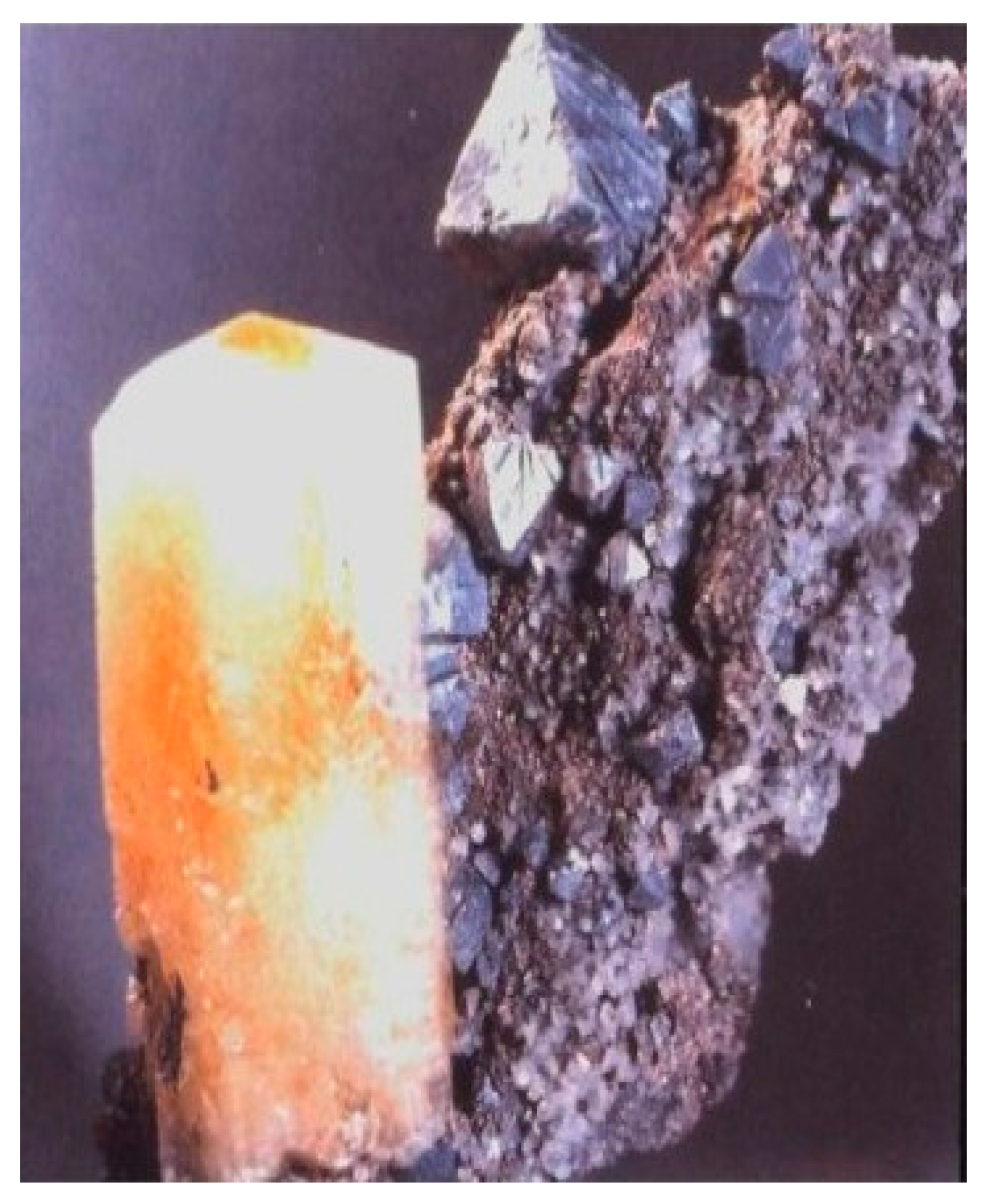
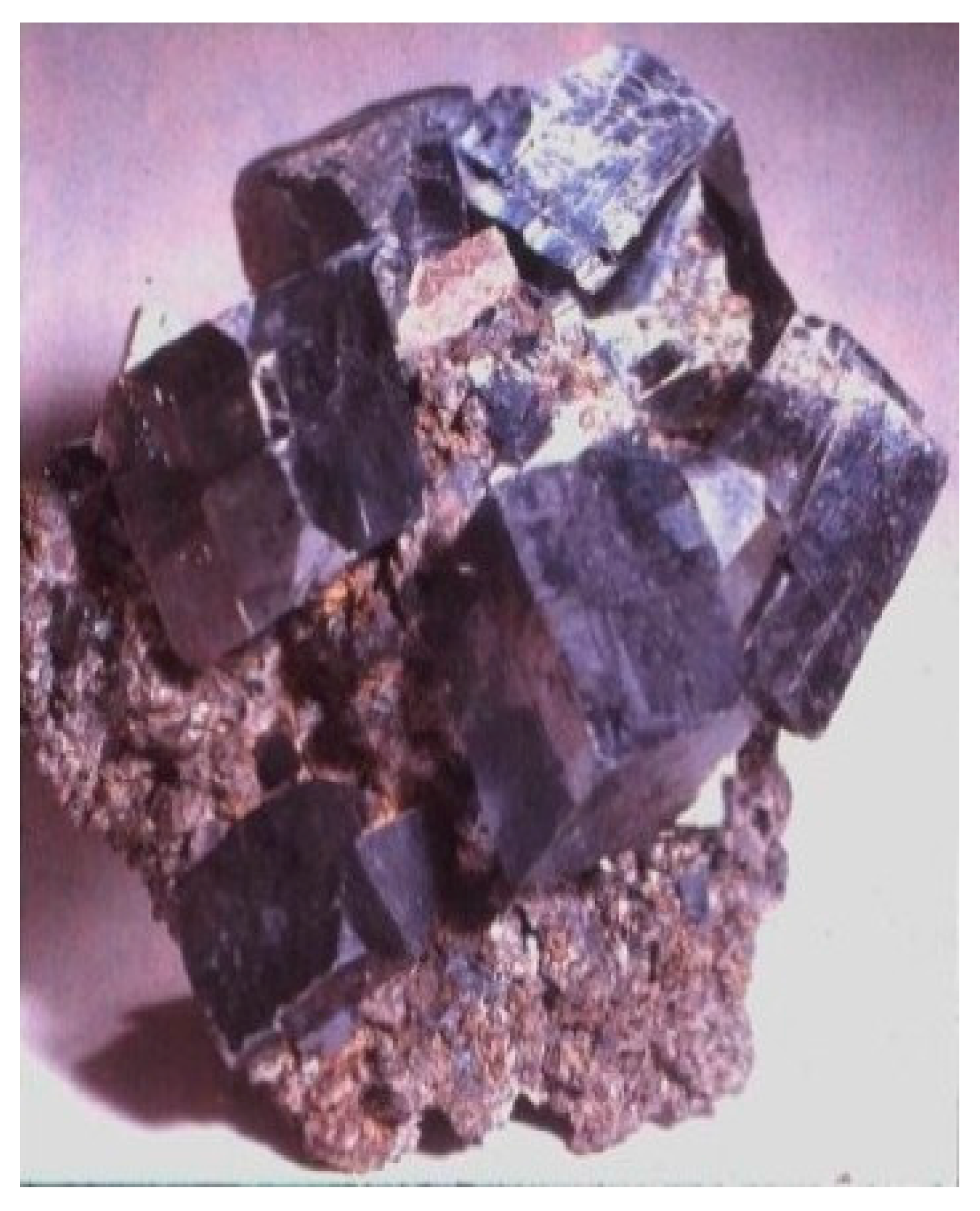
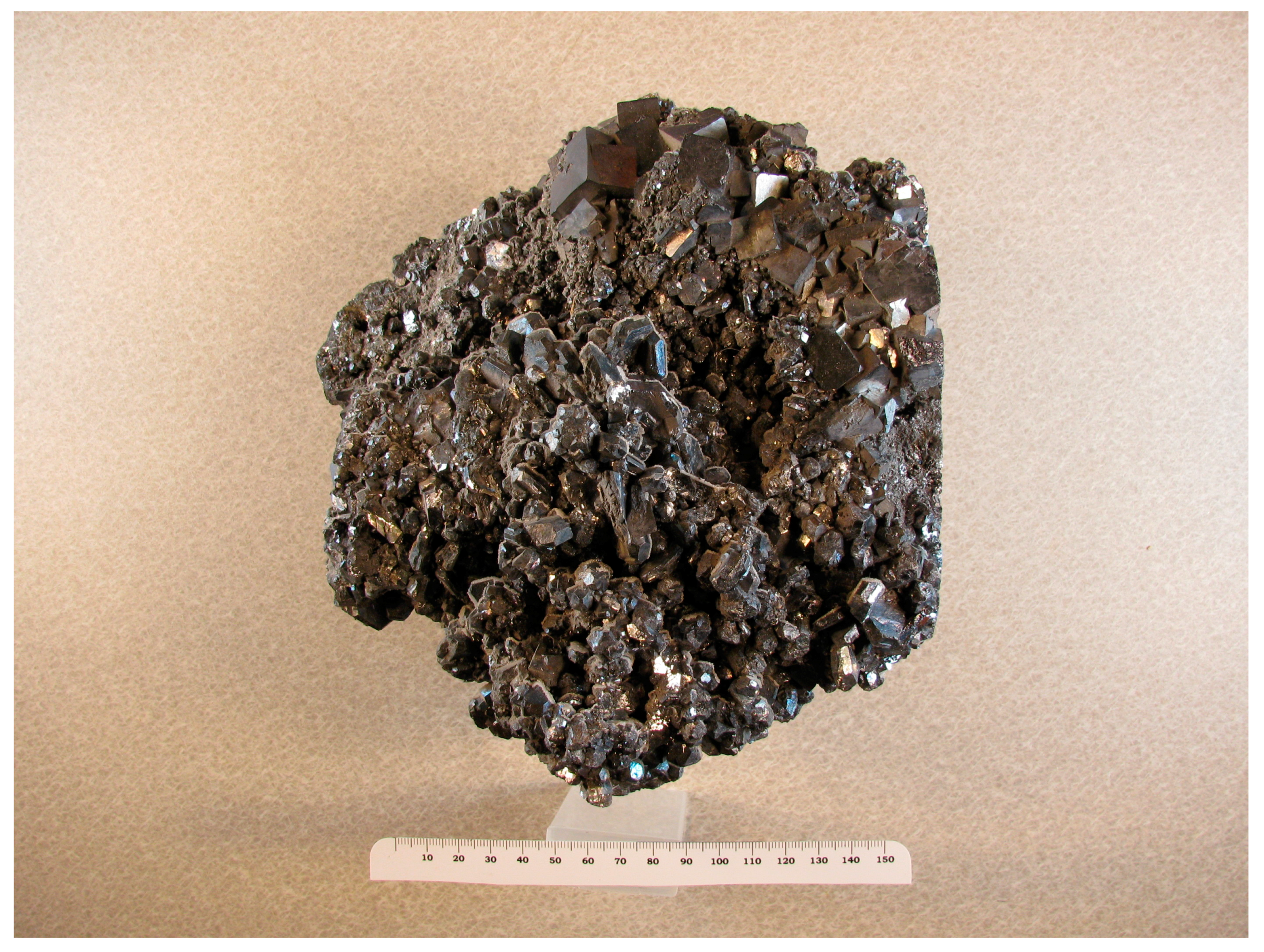
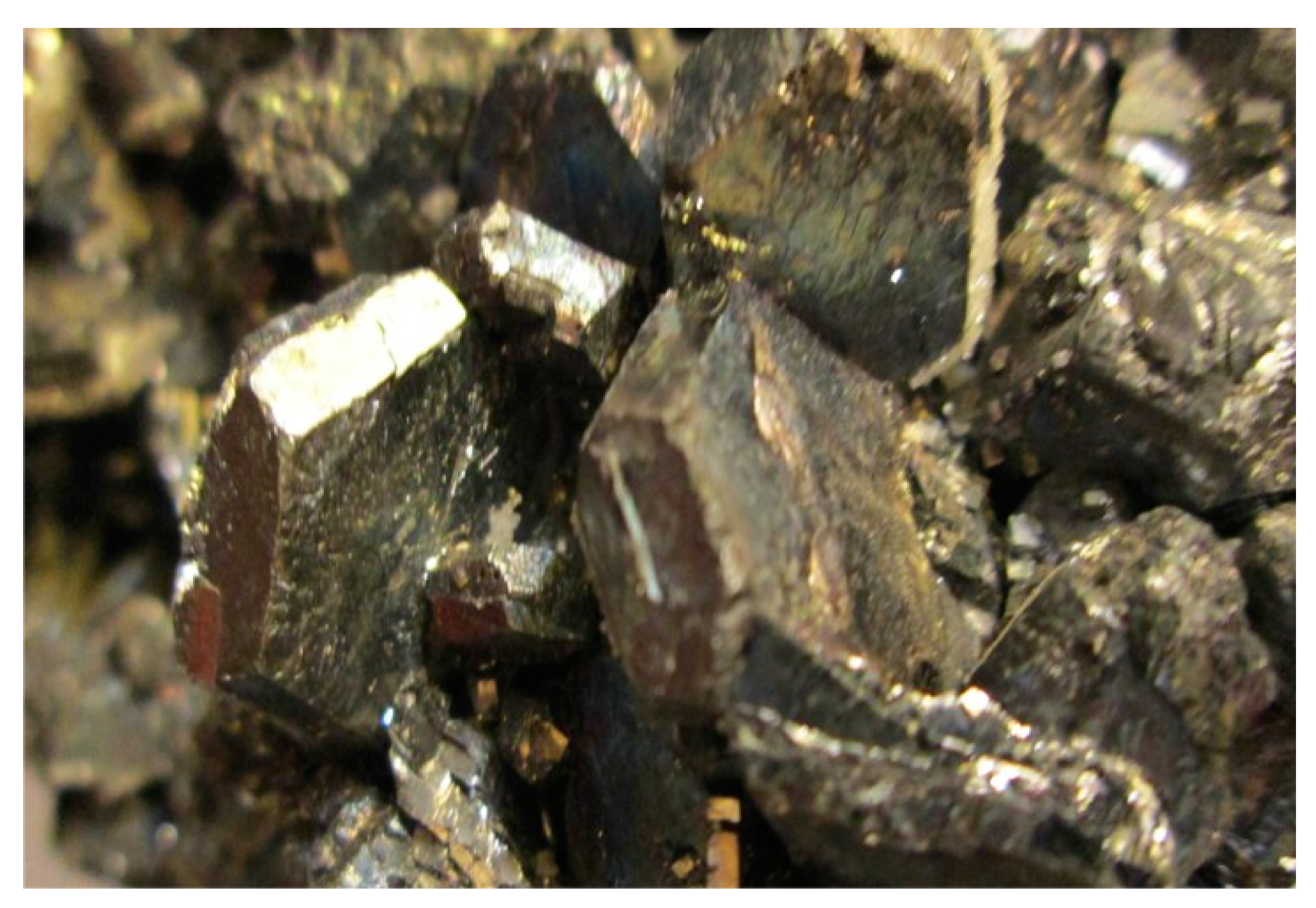
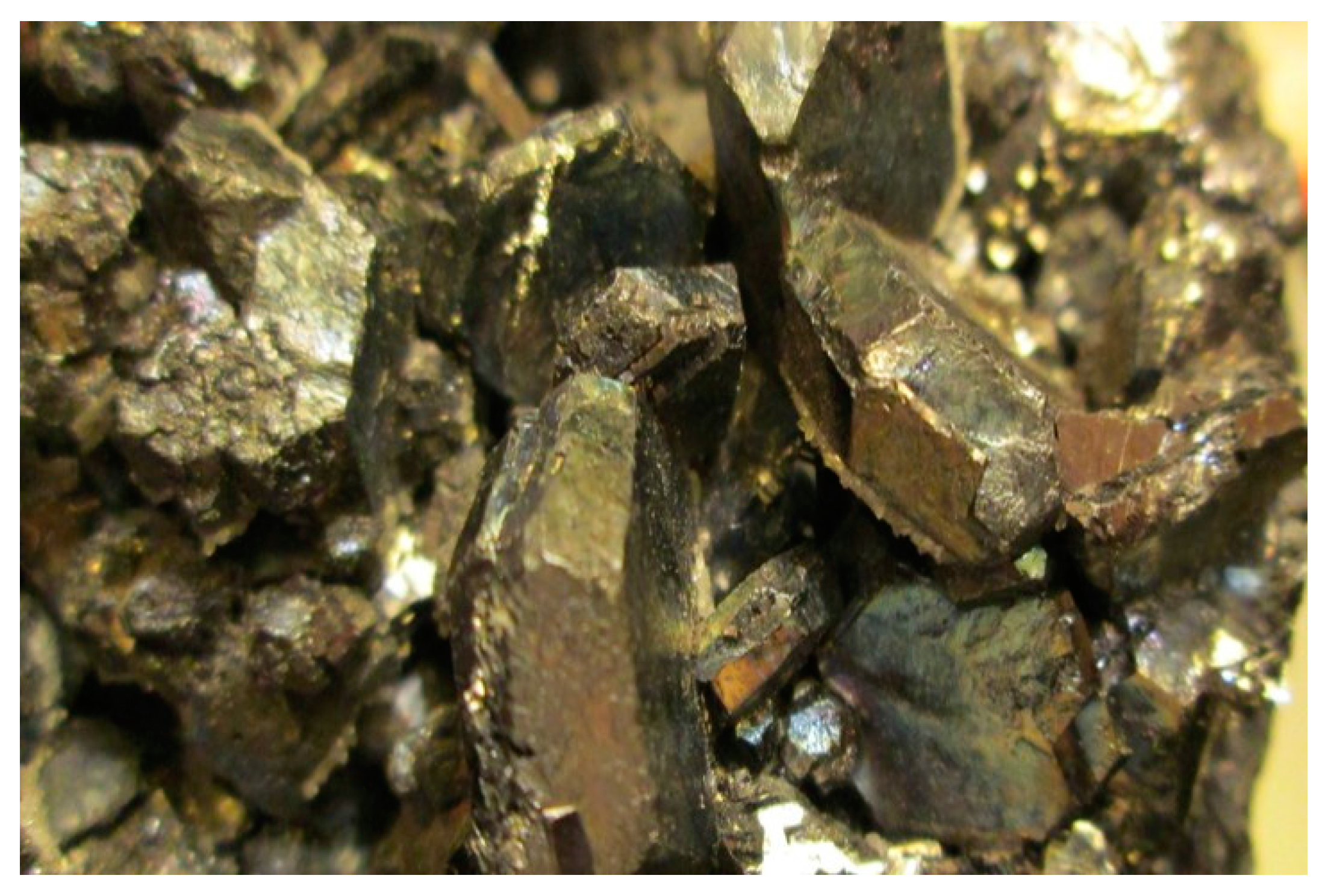
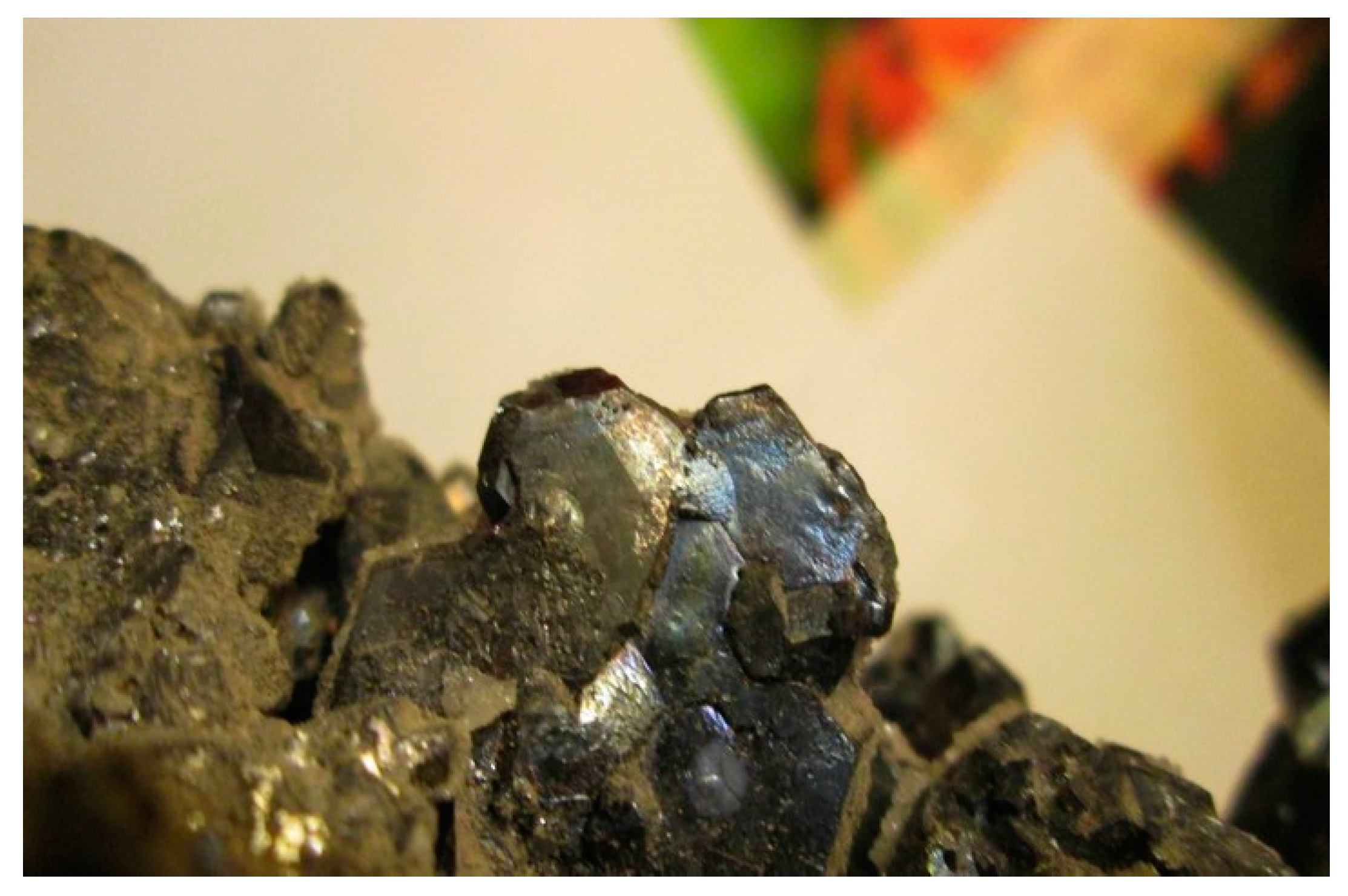
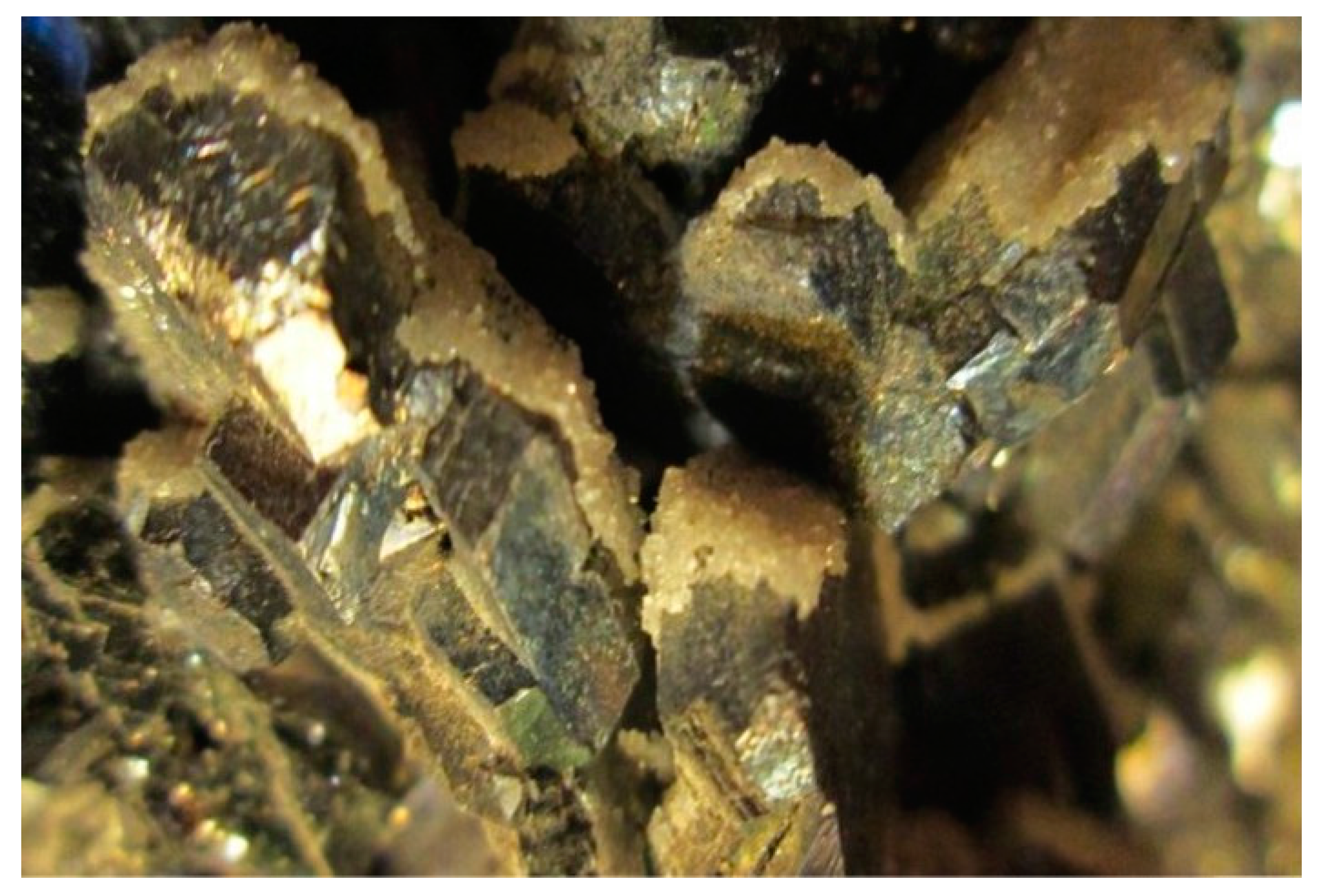
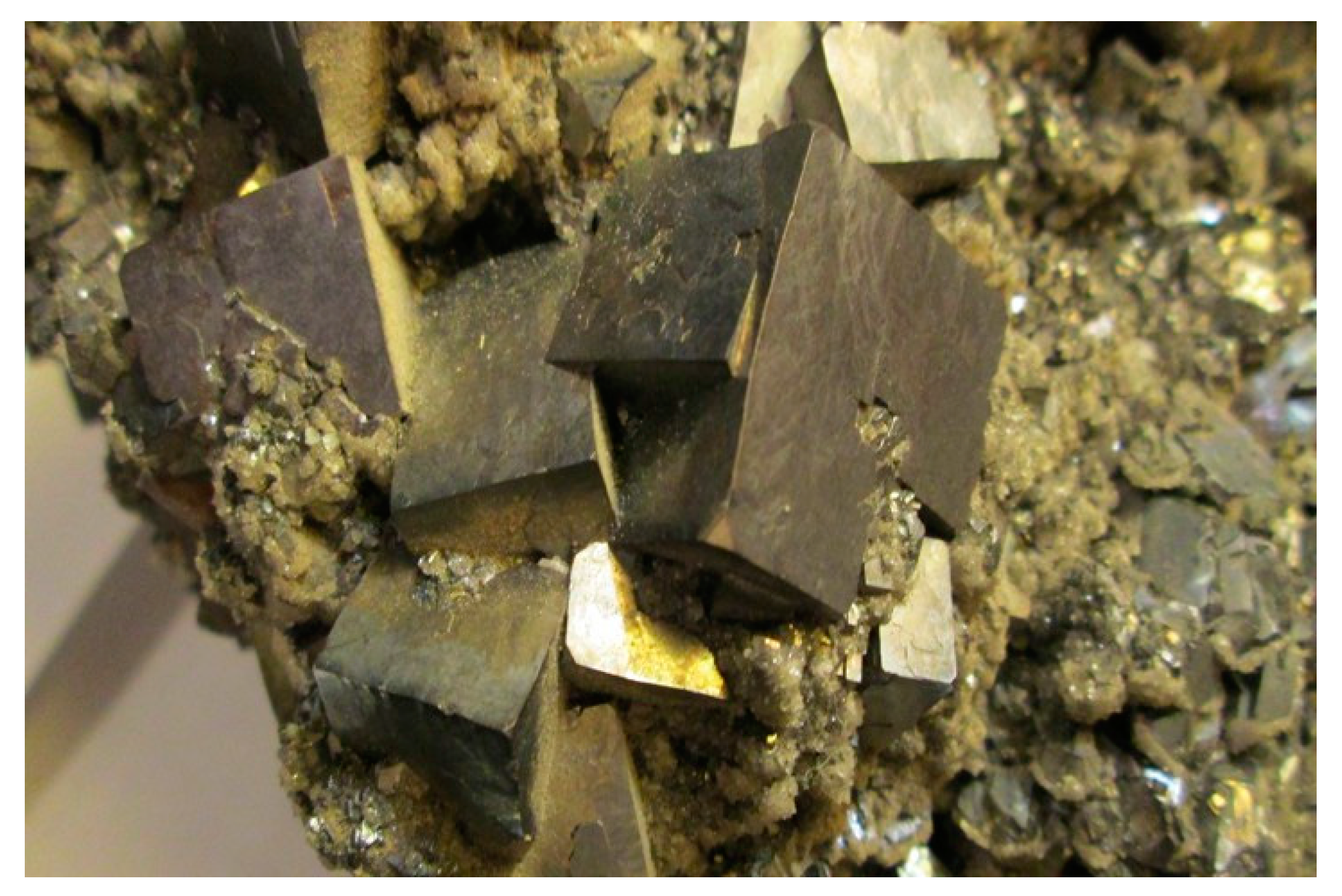
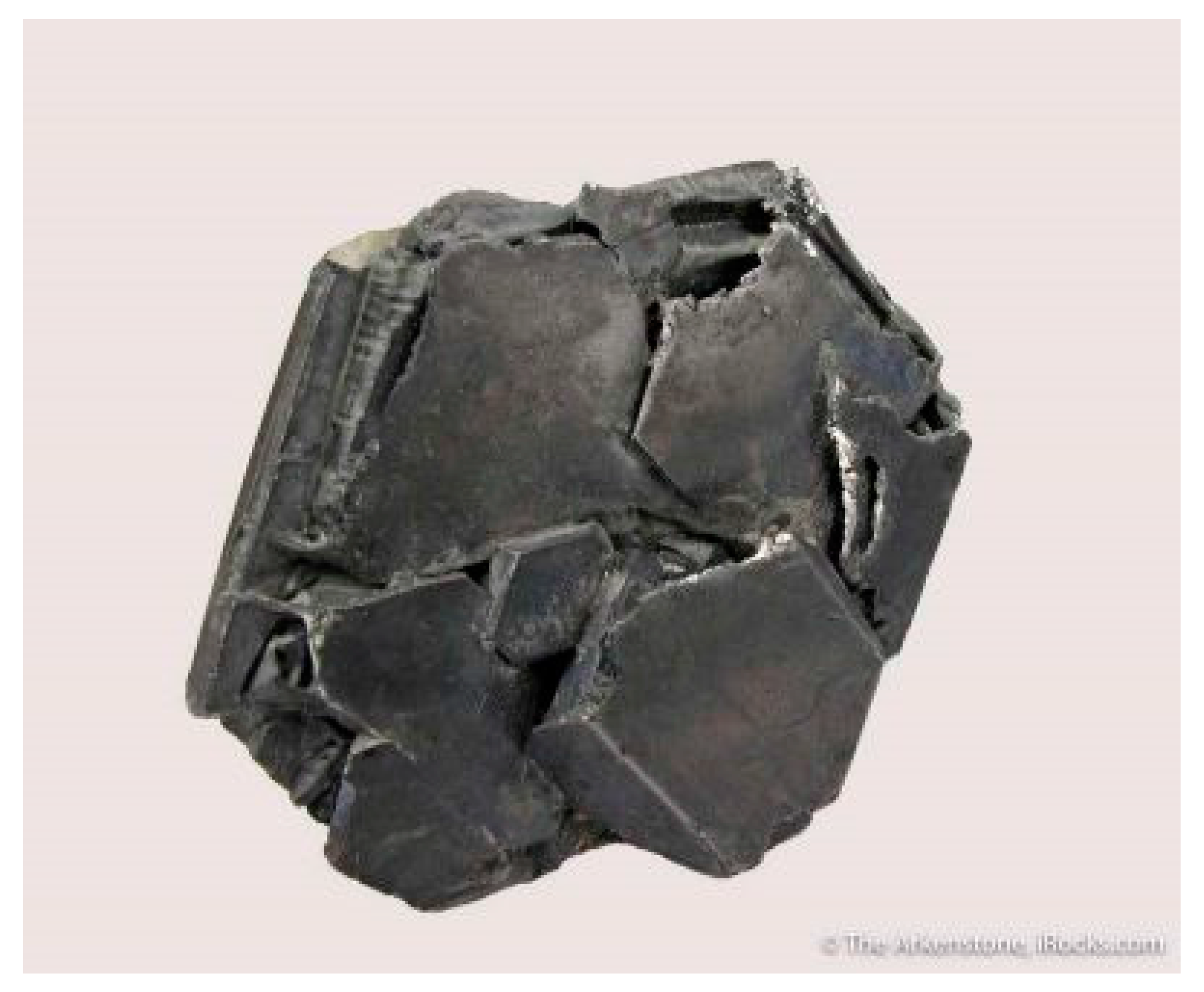
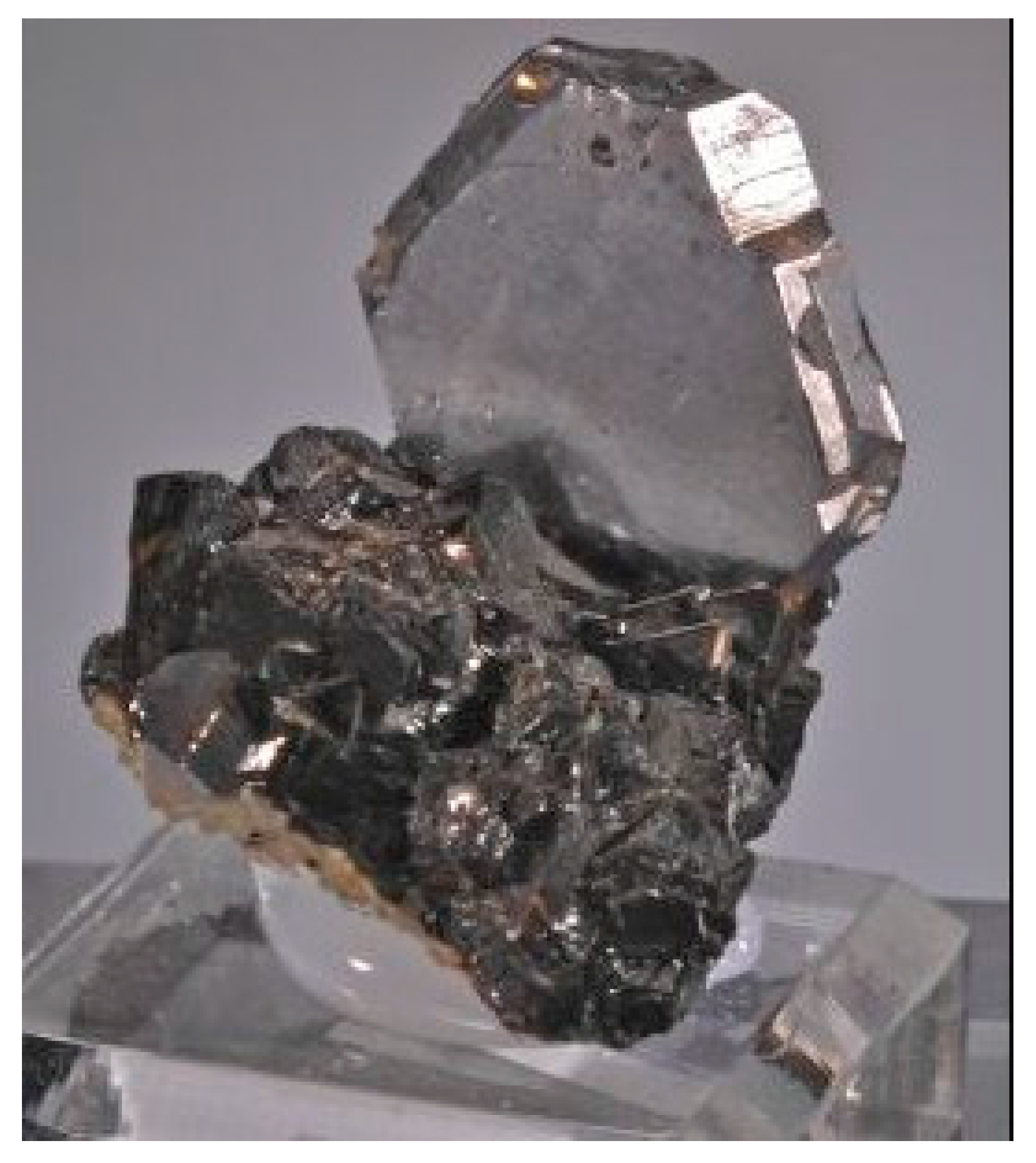
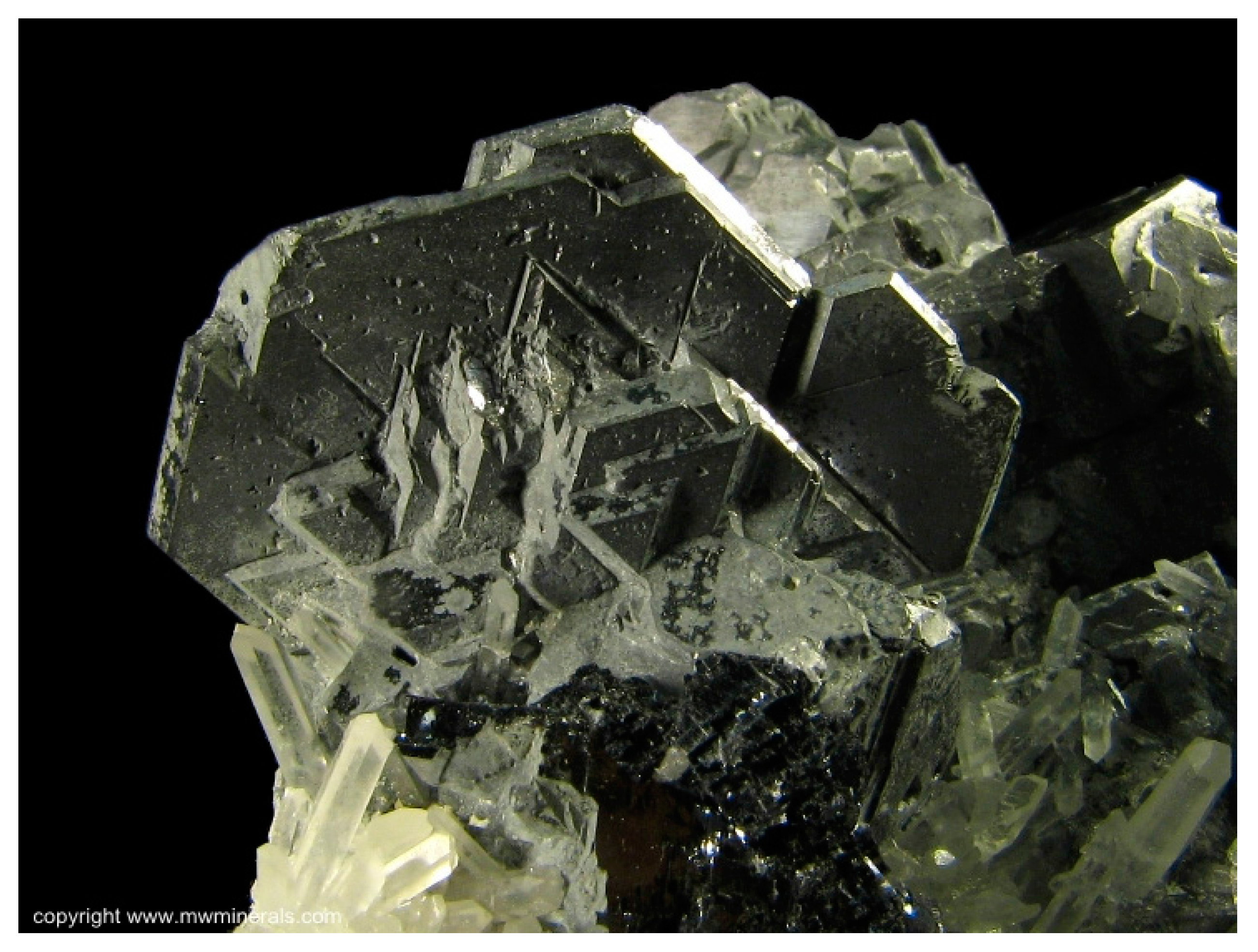
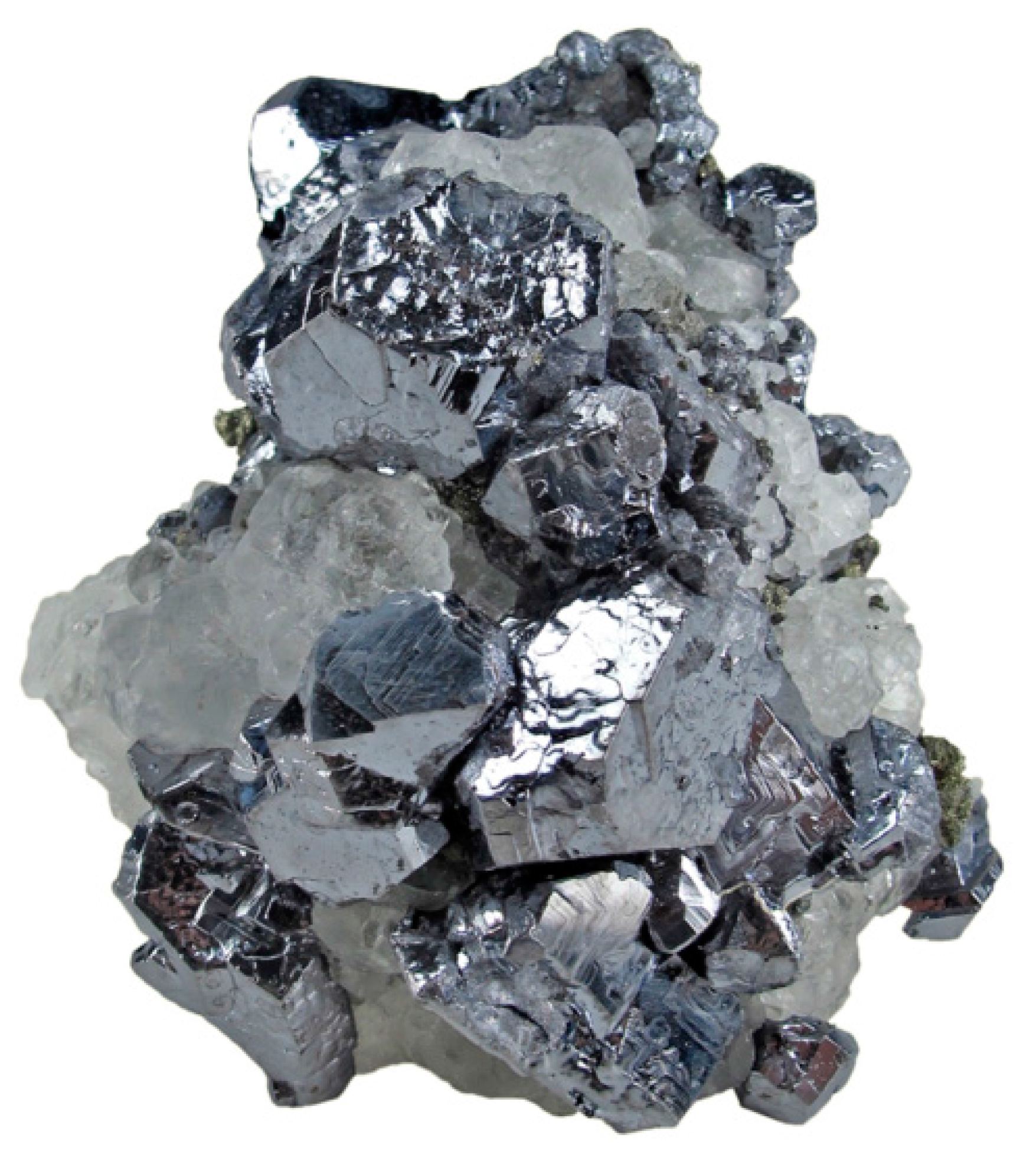
| Crystal Form | Ag | Bi | Sb | No. Analyses |
|---|---|---|---|---|
| Cubic | 218 | 4 | 320 | 11 |
| Cubic-Octahedral | 367 | 161 | 373 | 6 |
| Octahedral-Cubic | 566 | 1358 | 141 | 4 |
| Octahedral | 6628 | 8700 | 110 | 1 |
| Spinel Twins | 770 | 1318 | 218 | 6 |
| Crystal Form | Ag | Bi | Sb | No. Analyses |
|---|---|---|---|---|
| Cubic | 88 | 50 | 189 | 186 |
| Octahedral | 18 | n.d. | 241 | 7 |
| Crystal Form | Ag | Bi | Sb | As |
|---|---|---|---|---|
| Cubic | 5.5 | <2 | 97 | 2 |
| Octahedral | 3.1 | <2 | <2 | <2 |
© 2018 by the author. Licensee MDPI, Basel, Switzerland. This article is an open access article distributed under the terms and conditions of the Creative Commons Attribution (CC BY) license (http://creativecommons.org/licenses/by/4.0/).
Share and Cite
Hagni, R.D. Platy Galena from the Viburnum Trend, Southeast Missouri: Character, Mine Distribution, Paragenetic Position, Trace Element Content, Nature of Twinning, and Conditions of Formation. Minerals 2018, 8, 93. https://doi.org/10.3390/min8030093
Hagni RD. Platy Galena from the Viburnum Trend, Southeast Missouri: Character, Mine Distribution, Paragenetic Position, Trace Element Content, Nature of Twinning, and Conditions of Formation. Minerals. 2018; 8(3):93. https://doi.org/10.3390/min8030093
Chicago/Turabian StyleHagni, Richard D. 2018. "Platy Galena from the Viburnum Trend, Southeast Missouri: Character, Mine Distribution, Paragenetic Position, Trace Element Content, Nature of Twinning, and Conditions of Formation" Minerals 8, no. 3: 93. https://doi.org/10.3390/min8030093
APA StyleHagni, R. D. (2018). Platy Galena from the Viburnum Trend, Southeast Missouri: Character, Mine Distribution, Paragenetic Position, Trace Element Content, Nature of Twinning, and Conditions of Formation. Minerals, 8(3), 93. https://doi.org/10.3390/min8030093




